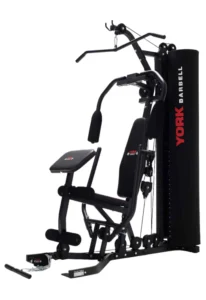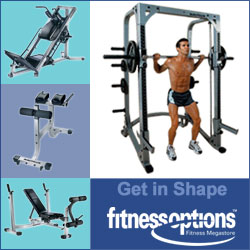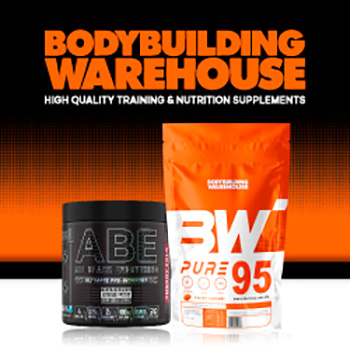
Key Takeaways
- High intensity home workouts can burn up to 30% more calories than traditional steady state training while requiring minimal space and equipment. Investing in the best home multi gym can enhance these workouts significantly.
- HIRT (High Intensity Resistance Training) combines the fat burning benefits of HIIT with muscle building resistance work for maximum efficiency
- Strategic workout structures like Tabata, EMOM, and circuit training can transform a simple home gym setup into a fat torching, muscle building powerhouse
- Best home multi gym systems offer space efficient solutions for complete body workouts with progressive resistance possibilities
- Crunch Fitness experts recommend incorporating 2-3 high intensity sessions weekly for optimal results without overtraining
You no longer need an expensive gym membership to get the fitness results you want. High intensity home gym workouts have changed the way we approach fitness, delivering professional level results using minimal space and equipment.
It’s a proven fact, with the right strategy, high intensity workouts at home can be just as effective, if not more so, than spending hours at a commercial gym. By learning about the science behind high intensity workouts and using the right workout structures, you can turn your home gym into your personal transformation centre.
Understanding the Science of HIIT and Multi Gym Training
High intensity interval training (HIIT) and its sibling, High Intensity Resistance Training (HIRT), have revolutionized home workouts by offering scientifically backed techniques to optimize results in a short amount of time. These methods involve alternating between periods of high effort and short rest, creating a metabolic state that continues to burn calories even after your workout is over. Studies have shown that well designed high intensity workouts can burn 25-30% more calories than traditional steady state exercise.
The beauty of high intensity training for home workouts is its flexibility. The intensity is derived from your effort and work to rest ratio, not necessarily from complex equipment. This means that even with limited space and basic equipment, you can achieve great results if the workout structure focuses on keeping your heart rate high and challenging your resistance levels.
These workouts are even more effective when combined with a smart use of multi gym equipment. Multi gyms offer smooth transitions between exercises, helping you maintain your elevated heart rate, which is so important. Plus, they offer progressive resistance options that can increase as your strength does.
The Reason High Intensity Workouts Burn More Fat
High intensity workouts burn more fat due to their unique metabolic effects. While traditional steady state cardio mainly burns calories during the workout, high intensity training triggers a series of metabolic reactions. When you exert near maximum effort, your body has to activate more muscle fibres, use more energy systems, and accrue a significant oxygen debt that has to be repaid after the workout.
Here’s where your multi gym setup really pays off, letting you work multiple muscle groups in a row with no break. This method cranks up the calorie burn and hormonal response. The metabolic stress from the right kind of high intensity resistance training sparks the release of growth hormone and other fat burning hormones that traditional cardio just can’t touch.
The Afterburn Effect: Calories Continue To Burn Long After Your Workout
One of the most exciting benefits of high intensity home workouts is the afterburn effect, also known as excess post exercise oxygen consumption (EPOC). This is a major departure from traditional workouts, where calorie burning ends when your workout does. With high intensity training, your body experiences a metabolic disturbance that causes it to continue burning extra calories for up to 24-48 hours after your workout.
The afterburn effect is caused by the intense disruption high intensity workouts cause to your body’s homeostasis. Your metabolism stays elevated as your body works to restore oxygen levels, replenish energy stores, repair muscle tissue, and clear lactate. A well designed 30-minute high intensity workout on the best home multi gym can potentially burn more total calories than a traditional 60-minute workout when you take the afterburn effect into account.
Studies have demonstrated that the size of this effect is directly proportional to the intensity of the workout. This is why short, high intensity bursts of effort with minimal rest periods are the main elements of effective home training programs.
Preserving Muscle Mass While Losing Fat
A lot of people don’t realize that one of the best things about high intensity resistance training at home is that it helps you keep your muscle mass while you’re trying to lose fat. When you’re trying to lose fat by eating less, you often end up losing muscle along with the fat, which can leave you looking “skinny fat” and slow down your metabolism.
When you use your home multi gym for high intensity resistance training, you put the mechanical tension and metabolic stress on your body that it needs to keep its muscle tissue even when you’re not getting as many calories as you need. The resistance part is really important it’s not enough to just get your heart beating faster, you have to put your muscles to the test with increasing resistance to keep the muscle mass you’ve worked so hard to build while you’re getting rid of fat.
Keeping muscle mass has a significant impact on body composition and metabolism over the long term. At rest, every pound of muscle burns about 6 calories per day, while fat tissue burns only 2 calories. Thus, preserving muscle is crucial for maintaining your results once you’ve achieved them.
5 Crucial High Intensity Home Workout Formats
The key to successful home training is knowing and applying the correct workout formats. These five methods can turn even the simplest best home multi gym setup into a machine that delivers results. Each format creates the ideal conditions for burning the most calories, stimulating muscle, and being efficient enabling you to accomplish more in less time with whatever equipment you have on hand.
1. Tabata Style Training (20 seconds on/10 seconds off)
Tabata training is one of the most time efficient ways to do high intensity home workouts. Created by Japanese scientist Dr. Izumi Tabata, this method requires 20 seconds of maximum effort followed by just 10 seconds of rest, repeated for 8 rounds (4 minutes total). This tough but efficient ratio creates a significant oxygen debt and metabolic stress that continues to burn calories long after you’re done.
2. Circuit Training With Little to No Rest
Circuit training allows you to use your home multi gym as more than just a strength building machine. It becomes a comprehensive conditioning system. By doing 5-8 exercises in a row with very little rest (15-30 seconds at most between exercises), you create a cardiovascular demand that’s similar to traditional cardio. At the same time, you’re building strength and muscle.
A great home gym circuit includes exercises that focus on different muscle groups in a row, which gives one part of your body a chance to rest a little while another part is working. For instance, you could do a pressing exercise followed by a pulling exercise, or work on your upper body and then switch to your lower body. This keeps your heart rate up but doesn’t let any one muscle group stop you from getting the most out of your workout.
To get the most out of your workout, make sure your circuit includes at least one exercise from each of the basic movement patterns, pushing, pulling, squatting, hinging, and core stabilization. This well rounded approach helps to ensure balanced muscle development while burning the maximum amount of calories.
3. EMOM (Every Minute On the Minute) Workouts
EMOM training adds a level of precision and progressive intensity to your home workouts by providing a structured framework that’s easy to follow. You start each minute by performing a specific number of repetitions, then rest for the rest of that minute before starting the next exercise. This self regulating rest period allows for natural progression as you get more tired, your rest periods will naturally get shorter, which increases the intensity of the workout.
EMOM training is particularly effective with multi gym equipment due to the ability to quickly adjust weights, allowing for a smooth transition between exercises. A common EMOM may include alternating between upper and lower body movements each minute for a total of 20-30 minutes. The advantage of this method is its quantifiability by monitoring the remaining rest time at the end of each minute, you have tangible proof of your improving fitness.
4. AMRAP (As Many Rounds As Possible)
AMRAP workouts are a great way to ensure you’re always pushing yourself when working out at home. The idea is to set a timer for 10-20 minutes and then do as many rounds as possible of a pre-set circuit of 3-5 exercises in that time. Make sure to keep count of how many rounds you manage to do.
The built in performance metric of AMRAP makes it especially useful for home multi gym training. By keeping track of your rounds and repetitions, you set clear goals for future sessions. This feedback loop drives continuous improvement and prevents plateaus. The competitive element even if only competing against yourself increases intensity levels beyond what most people achieve in traditional workouts.
When choosing exercises for AMRAP, pick those that you can do safely even when you’re tired. The aim is to keep moving properly while pushing the limits of what you can do.
5. Pyramid Training for Gradual Intensity
Pyramid training is a great way to naturally increase intensity, making it an excellent choice for the best home multi gym workouts. Start off with a high number of repetitions with a lighter weight, then gradually increase the weight and decrease the number of repetitions as you get to the middle of your pyramid. Then, reverse this process until you’re back to doing a high number of repetitions. This method is great because it combines metabolic stress (doing a high number of reps) with mechanical tension (lifting heavier weights).
Let’s take a chest press as an example. You might do 15 reps at a light setting, then 12 at a moderate setting, then 8 at a challenging setting, and then work your way back down with 12 and then 15 reps. The great thing about pyramids in home training is that they stimulate all muscle fibre types while also creating a significant cardiovascular demand during the high rep phases.
Multi Gym Equipment: Get the Most Out of Your Space and Your Workouts
Having a well structured multi gym system at home can turn your small workout space into a fully equipped gym that can give you professional level results. Instead of having a collection of separate pieces of equipment, a good quality multi gym offers a complete resistance training system that lets you move from one exercise to the next without interruption, which is vital when doing high intensity training to keep your heart rate up. Trainers at Crunch Fitness often recommend multi gyms to their clients who want to get the most out of their workouts in a small home space.
Today’s best home multi gym systems are a far cry from the clunky, limited machines of yesteryear. Modern options include multiple cable positions, adjustable resistance mechanisms, and integrated bodyweight training stations, all of which offer hundreds of potential exercises in a compact footprint. This versatility allows for genuine high intensity training by removing the rest periods usually required to adjust separate pieces of equipment.
Top Multi Gym Features That Are Worth The Investment
If you’re planning to invest in a home multi gym system, you should prioritize features that allow for genuine high intensity training protocols. Look for continuous resistance mechanisms such as weight stacks or magnetic systems that allow for quick transitions between exercises. Multiple cable attachment points can greatly increase the variety of exercises you can do, and adjustable seats and pads ensure you can position yourself correctly, no matter your body proportions.
The key feature for a multi gym in high intensity training is a design that allows for full body, compound movements, not just isolated exercises. Systems that let you do standing cable presses, squats, rows, and rotational movements offer far more training options than those that limit you to seated, isolated movements. This functionality turns your equipment from a muscle building machine into a total metabolic conditioning system.
When you’re working out at a high intensity, durability is key. The fast pace and greater forces mean there’s more stress on the mechanical parts of your equipment. That’s why it’s worth investing in commercial grade bearings, thick upholstery and robust frame connections. They might cost more, but they’ll stand up to intense training for many years.
Compact Design Features
The latest best home multi gym systems are designed to save space with foldable mechanisms, vertical storage options, and adaptable designs that can fit into different room layouts. Wall mounted cable systems offer incredible flexibility and take up less than 10 square feet of floor space. Some companies have even created “hide away” systems that can be hidden in cabinets or under furniture when not in use. This makes high performance equipment possible even in small studio apartments.
Flexibility for Various Fitness Stages
The perfect home multi gym evolves with you, offering step by step resistance that tests beginners and still offers sufficient load capacity for advanced athletes. Look for systems with broad resistance ranges and minor incremental adjustments that allow for exact progression. Some of the latest models include digital resistance tracking that automatically recommends suitable increases based on your performance, essentially incorporating the expertise of a personal trainer.
Your Ultimate 30-Minute High Intensity Multi Gym Workout
This thorough workout makes the most of high intensity training principles while using the full potential of a home multi gym system. In just 30 minutes, you’ll engage every major muscle group and create the metabolic disturbance needed to keep burning calories long after you’re done. The workout has a strategic structure that slowly increases intensity before tapering down, which is the best way to optimize both performance and recovery.
Getting Started with a Warm-Up (5 minutes)
Start with 2 minutes of light cardio movement such as marching on the spot or gentle jumping jacks to raise your core temperature. Then do one set of 8-10 reps at 50% effort on each exercise you’ll do in your main workout. Concentrate on correct form and gradually increasing range of motion rather than intensity at this point. This specific warm up readies the neuromuscular system for peak performance and reduces the risk of injury during the high intensity phases that come next.
Primary Exercise Circuit (20 minutes)
Execute this circuit 4 times over with little to no rest between exercises and 60-90 seconds of rest between entire circuits. Use a weight or resistance level that makes the prescribed repetitions difficult but doable with proper form. For maximum results, go directly from one exercise to the next, using the transition time as your only break.
1. Cable Squat Press: 12 reps – Stand in front of a low cable, holding handles at shoulder height. Squat down, then as you stand up, press the handles above your head. This compound movement engages the entire kinetic chain.
2. Seated Row to Rotation: 10 reps each side – From a seated position, do a row, then rotate your torso to one side while maintaining the contraction. Alternate sides with each repetition.
3. Cable Reverse Lunge with Bicep Curl: 8 reps each leg – Stand facing the machine, step back into a reverse lunge while simultaneously doing a cable curl. Return to standing and repeat on the opposite leg.
4. Push up on Machine Handles or Bench: 12-15 reps – Use the multi gym handles or bench to do push ups with proper depth and hand position.
5. Cable Woodchop: 10 reps each side – From high to low diagonal pattern, engage core and hip rotation while maintaining stable lower body position.
Post Workout Cool Down (5 minutes)
The cool down period is essential to kick starting your body’s recovery process while your metabolism is still high. Do 2-3 minutes of light exercise (like walking in place or easy step touches) to slowly lower your heart rate while keeping your blood circulating. Then, do static stretches for each main muscle group, holding each stretch for 20-30 seconds without bouncing. Focus especially on the muscle groups that you worked the hardest during your workout.
By implementing a strategic cool down, you can prevent blood from pooling, which can happen if you suddenly stop exercising. It also starts the recovery process to help you get the most out of your workouts. In addition, a good cool down can lessen the soreness you feel after a workout and help you prepare for your next high intensity session.
If you’re the kind of person who likes to keep track of their workout progress, make a note of how long it took you to complete your workout, what resistance levels you used, and how hard you found it on a scale of 1-10. This way, you’ll have a benchmark to measure your future progress against. The best way to tell if you’re improving is if you can do the same workout faster or with more resistance.
Don’t Have a Multi Gym? No Worries: High Intensity Workouts with Little Equipment
Just because you don’t have the best home multi gym doesn’t mean you can’t do high intensity workouts at home. With a little ingenuity and the right workout plan, you can get amazing results with very little equipment or even just your own body weight. The main principles of high intensity workouts maximum effort, minimal rest, and full body workouts can be applied to any type of resistance. In fact, some of the most demanding workouts for your metabolism require nothing more than your own body and gravity.
Boosting Bodyweight Intensity
Bodyweight training can become genuinely high intensity by manipulating leverage, tempo, and rest periods. You can dramatically increase the difficulty of standard exercises without adding external weight by changing hand or foot positions. For push ups, elevating your feet increases upper chest and shoulder involvement while making the movement significantly more challenging. For squats, narrowing your stance and adding a pulse at the bottom intensifies quad engagement without requiring additional resistance.
Another way to intensify your workout at home without equipment is through time under tension. By slowing down the eccentric (lowering) phase of each movement to 3-5 seconds, you can cause more muscle damage and metabolic stress than you would with normal speed repetitions. This technique is particularly effective for bodyweight pulling movements like inverted rows under a sturdy table and pushing exercises like decline push ups with your feet elevated on a couch or chair. For more insights on maximizing your home gym workouts, check out this comprehensive overview.
Keep An Eye On Your Goals: Important Measurements In Home Workouts
Keeping track of the right measurements can turn a simple workout into a strategic training plan, especially when it comes to high intensity home workouts. Without the accountability of a gym setting, it’s crucial to monitor your own progress to continue improving. The best way to track your progress is to combine performance measurements, body composition measurements, and recovery markers. This gives you a full view of your fitness journey and helps you avoid the plateaus that often come with home workout programs.
Looking Past the Scale: Performance Indicators
Even though weight loss is often a goal, the scale doesn’t give a full picture of the benefits of high intensity training. Instead, focus on performance metrics that show direct improvements in work capacity and strength. Keep track of how long it takes you to complete benchmark workouts, how long it takes you to finish specific circuits, or how many rounds you can do in timed AMRAP sessions. These measurements show cardiovascular and muscular improvements even when the scale isn’t changing.
When you’re doing resistance based exercises, don’t just jot down the weight you used. Make sure you also note the total volume, which is the weight times the reps times the sets. This will give you a much clearer picture of the overall training stimulus. You might be surprised to find that you’re making more progress than you thought. Another great way to track your progress is by using the rate of perceived exertion (RPE) scale. This is a scale from 1 to 10 that measures how hard an exercise feels. By keeping track of this, you can see improvements in efficiency and conditioning that you might not have noticed otherwise.
Using Technology to Monitor Your Workouts
Thanks to technology, you can now monitor your home workouts with apps and devices that provide professional level analysis. With wearable heart rate monitors, you can get immediate feedback on the intensity of your workout. This way, you can make sure you’re reaching the 85%+ maximum heart rate that is necessary for optimal high intensity training effects. Many of these devices can also calculate your training load scores and recovery metrics. This can help you avoid overtraining while making sure you’re getting enough stimulus for adaptation.
There are a variety of apps available for the best home multi gym users that feature a library of exercises tailored to home gym equipment, complete with built in progression tracking. These platforms often offer visual displays of your progress trends, allowing you to spot patterns that might not be immediately obvious when looking at individual workout data. Some of the more advanced systems even sync up with your equipment to automatically record weights, reps, and rest periods, providing a seamless tracking experience that promotes consistency.
The First Fortnight: Kickstarting High Intensity Training at Home
The first couple of weeks of high intensity training are crucial. They lay the groundwork for both the physical changes and mental habits that will dictate your long term results. This beginning stage should slowly ramp up the intensity, while prioritizing correct form and the structure of the workout. Start off with three sessions a week, alternating between full body circuit style workouts and targeted HIIT sessions that focus on specific movements or energy systems.
Start your high intensity workouts with longer work and rest periods than you’ll ultimately need. For instance, begin with 30 seconds of exercise followed by 30 seconds of rest, and gradually move to the more demanding 40:20 or even 45:15 work to rest ratios as you get fitter. This gradual approach stops the overwhelming tiredness that often causes beginners to give up on high intensity routines before they start to see the advantages.
Workout Plan on a Daily Basis
For the best results, follow this 14-day introductory plan to high intensity home workouts, Day 1: Complete body circuit on the multi gym (4 rounds, 40 seconds of work/20 seconds of rest), Day 2: Active recovery with 20 minutes of light exercise, Day 3: Upper body focused HIIT with push pull supersets, Day 4: Rest or light mobility work, Day 5: Lower body and core circuit training, Day 6: Active recovery with a walk or light bike ride, Day 7: Full rest; Day 8: Tabata intervals with the multi gym for resistance, Day 9: Active recovery with yoga or stretching, Day 10: Full body EMOM workout (20 minutes), Day 11: Rest or mobility work, Day 12: Strength focused circuit with longer work intervals, Day 13: Light cardio activity (20-30 minutes), Day 14: Assessment workout repeat the circuit from Day 1 and compare performance metrics.
What to Do on Rest Days
Resting between high intensity workouts is as important as the workouts themselves. On rest days, do some light activity like walking, easy biking, or swimming to get your blood flowing without tiring you out. Spend 10-15 minutes doing mobility exercises that target any problem areas you’ve noticed during your workouts. Pay special attention to your hips, shoulders, and upper back, which are all areas that can improve your performance on multi gym exercises. Using a foam roller or massage tools can help you recover faster by easing muscle tension and improving the quality of your tissues. This is especially helpful for muscles that get a lot of use, like your quads, hamstrings, and the muscles in your back that you use when you row.
Take It to the Next Level: Knowing When and How To Ramp Up Your Workout Intensity
Smart progression is the secret to ongoing results from high intensity home training. After you’ve built your foundation in the first 2-3 weeks, start to systematically increase your intensity every 2-3 weeks to avoid hitting a plateau. The best way to progress is to follow a wave pattern instead of just increasing linearly, alternating between intensity phases and volume phases so you can recover but still keep making progress.
There are many ways to increase the intensity of your workout without just adding more weight. You can decrease your rest periods by five to ten seconds, increase your work intervals by the same amount, add explosive movements to your regular exercises, or use more challenging variations of exercises. For those who use a multi gym, changing the angle at which you pull or press can make the exercise more difficult without needing to add more weight. Be sure to keep track of your recovery markers when you increase the intensity of your workout. If your resting heart rate is more than five to eight beats above your baseline or if your performance decreases significantly between sessions, you may have increased the intensity too much and should adjust accordingly.
Commonly Asked Questions
Many people have questions about high intensity home training as they switch from regular gym workouts to more time saving methods. This section will address the most frequent concerns and misunderstandings about using these potent training methods at home. Knowing these subtleties can help you get the best results and avoid the usual mistakes that can hinder progress.
Every solution combines both the latest scientific studies and practical uses particularly for home training environments. Although individual results may differ, these guidelines offer dependable outlines for most trainees who want to use high intensity techniques with home equipment.
How many high intensity workouts should I do at home each week?
The majority of people will see the best results with 2-4 high intensity sessions each week, with at least 48 hours between workouts that target the same movements or energy systems. High intensity training that is truly effective will cause significant systemic fatigue and microtrauma to the muscles, which requires adequate recovery time before the next stimulation. Beginners should start with just two sessions a week, while intermediates can usually handle three, and advanced trainees may be able to do four sessions a week if they pay careful attention to recovery markers. These high intensity workouts should be supplemented with 1-2 weekly active recovery sessions that feature low intensity movement to aid recovery without adding to fatigue.






